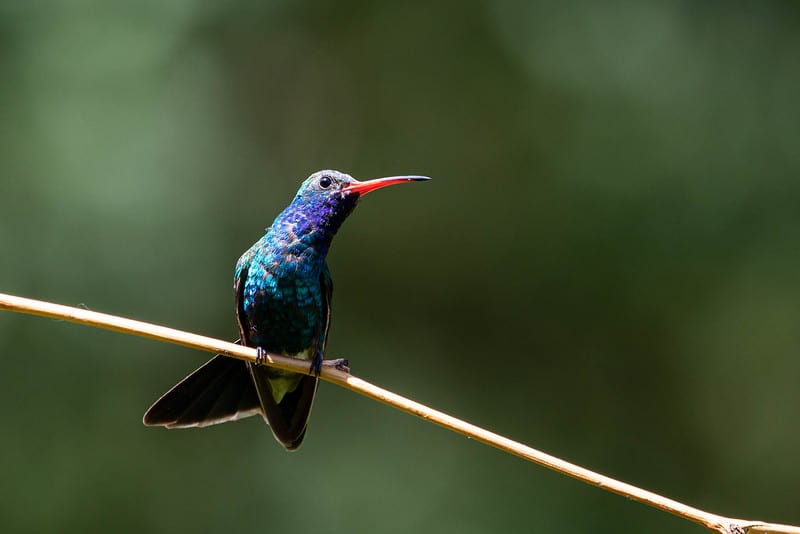Regardless of their tiny size, hummingbirds are one of the most easily identifiable types of birds around. They’re often very colorful, with iridescent plumage that shimmers in the right light. Even their personalities are vibrant — they’re commonly described as feisty and pugnacious birds that aren’t afraid to confront threats to their food or nests, such as other hummingbirds and animals. There are many kinds of hummingbirds found across America, but as far as the species of hummingbirds in Michigan go, there’s really only one.
Hummingbirds in Michigan
The 6 hummingbirds you may be able to see in Michigan include the ruby-throated hummingbird, rufous hummingbird, Anna’s hummingbird, Mexican violetear, white-eared hummingbird, and broad-billed hummingbird.
There is only one species of hummingbird that regularly occurs in Michigan — the ruby-throated hummingbird. However, there are a few other species that have been spotted in the state that don’t routinely travel here. Below we’ll discuss all of these species, however note that the appearance of the rare varieties cannot be guaranteed.
1. Ruby-Throated Hummingbird

As mentioned above, the Ruby-throated Hummingbird is the only one that is commonly found in Michigan. There are some other species that are rarely spotted in the state that we’ll go over below.
These hummingbirds range from a vibrant, emerald green, to yellowish-green on their upperparts and head, with white chests and underparts. Only males feature the bright red throat patch that their name implies. In the sunlight, it appears glittery and iridescent, but in the dark, the color dulls. The legs of this hummingbird are so short that they don’t hop or walk like other birds. Instead, they rely on flying or by shuffling along on a perch to move. Hummingbirds tiny legs are part of what got them placed in the taxonomic order, which means “without feet.”
Ruby-throated hummingbirds rely on flower nectar as a food source. Their rapidly beating wings can flap more than 50 times a second, enabling them to hover in front of a flower and use their long bill and tongue to sip the nectar inside. They’re very likely to visit backyard feeders, so be sure to set one up in your yard. Planting colorful red or orange flowers is another great tip for attracting them, as they seem to favor these colors. Not only will the birds appreciate the food, but they’ll likely remember the location for next year’s migration — increasing your chances of seeing them in the future.

The inquisitive nature of these hummingbirds makes watching them even more enjoyable. They quickly become habituated to humans and grow comfortable perching close to windows and porches to access feeders. The hummingbirds often stay perched near available food sources for the majority of the day, guarding their territory against rivals. Mothers will even compete with her offspring after they’ve fledged the nest.
As far as nesting goes, Ruby-throated hummingbirds aren’t interested in what you have to offer. They won’t build their nests in birdhouses or nesting boxes. Females prefer to build their nests out of natural materials such as grasses, plant fibers, and even spider webs. However, they like to build their nests in trees and shrubs, so having these on your property offers good shelter options.
Rare and occasional hummingbirds in Michigan
1. Rufous Hummingbird

The range of Rufous Hummingbirds doesn’t extend to Michigan, but they have been sighted multiple times in the state and are considered a rare visitor. Aside from the Ruby-throated hummingbird, it’s the most commonly spotted hummingbird in Michigan. When they are observed here it’s in the fall and winter, usually towards the end of the year. Otherwise, they’re found much farther west, breeding in the Pacific Northwest and Alaska.
Adult male Rufous hummingbirds are a beautiful rusty orange pretty much all over except for their white chests. Like Ruby-Throated Hummingbirds, they too have an iridescent patch on their throats, but it tends to be either red-orange or yellow-green in color.
2. Anna’s Hummingbird

Anna’s Hummingbirds are even rarer than Rufous Hummingbirds in Michigan. However, they have been recorded here a handful of times throughout the years. Like Rufous Hummingbirds, Anna’s Hummingbirds are birds of the Pacific Coast and are commonly found there year-round. They share a similar, iridescent green coloration as Ruby-throated Hummingbirds, with pretty, pink-colored throats. For hummingbirds, they’re medium-sized and rather chunky, with large heads.
3. Mexican Violetear

Another rare occurring hummingbird in Michigan is the Mexican Violetear. They’re also known as Green Violetears because of the violet ear patches on the sides of their heads. The rest of their bodies are covered in green plumage. These birds are typically found in the highlands of southern Mexico and Central America. They tend to be pretty nomadic and travel around mountain ranges. Far wandering individuals have reached Michigan multiple times, and some have even ended up as far north as Canada.
4. White-Eared Hummingbird

White-eared Hummingbirds are primarily found in the mountain forests of Mexico where they’re very common. Even in the southwestern United States, this bird is uncommon — so seeing it in Michigan is truly rare and very seldom happens. These are colorful hummingbirds, with dark heads, green bodies, and white markings on the sides of their faces.
5. Broad-Billed Hummingbird

Broad-billed Hummingbirds easily stand apart from other hummingbirds due to the bright red bill found on males. Like White-eared and Mexican Violetears they’re also predominantly found in Mexico, with rare exceptions occasionally being spotted in Michigan and other areas of the United States.
Talia is an animal enthusiast who enjoys researching and writing about birds and other wildlife. She loves sharing practical knowledge to help others better understand and appreciate the natural world.

